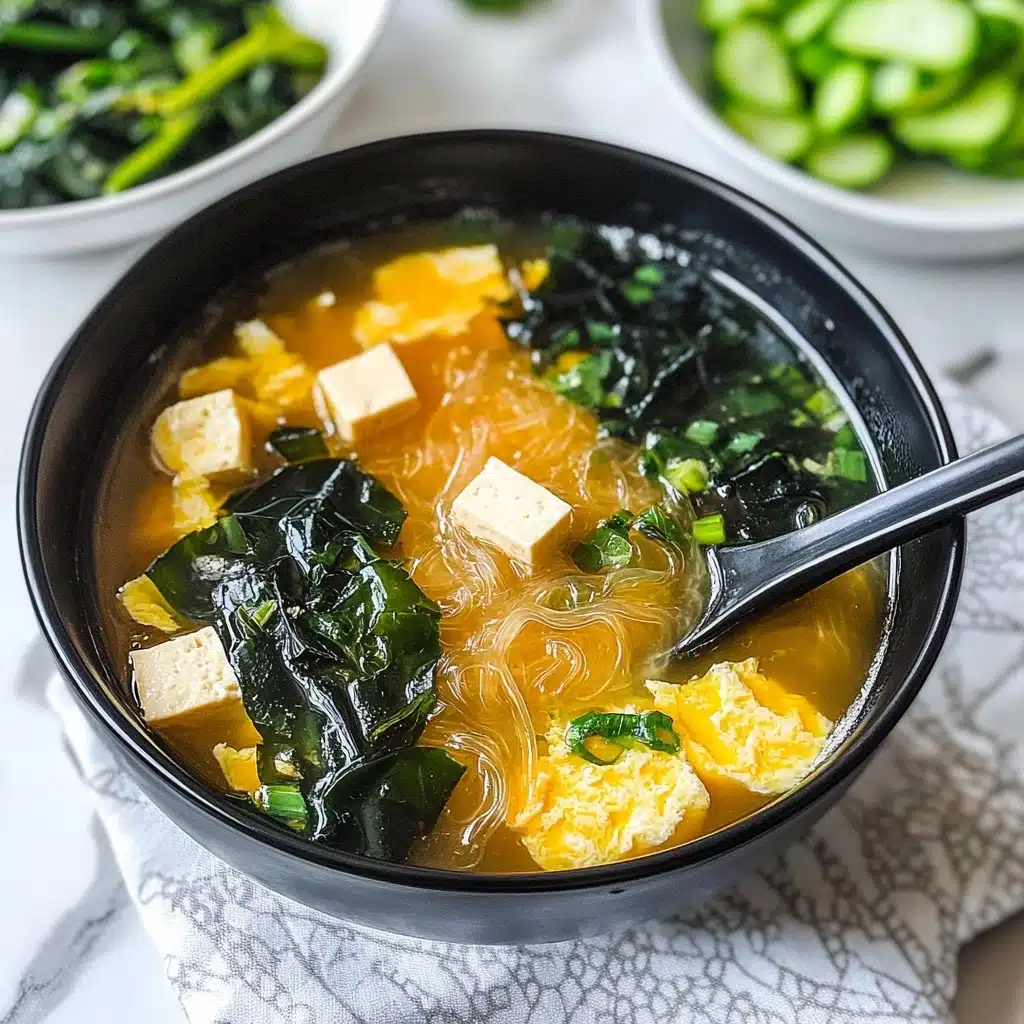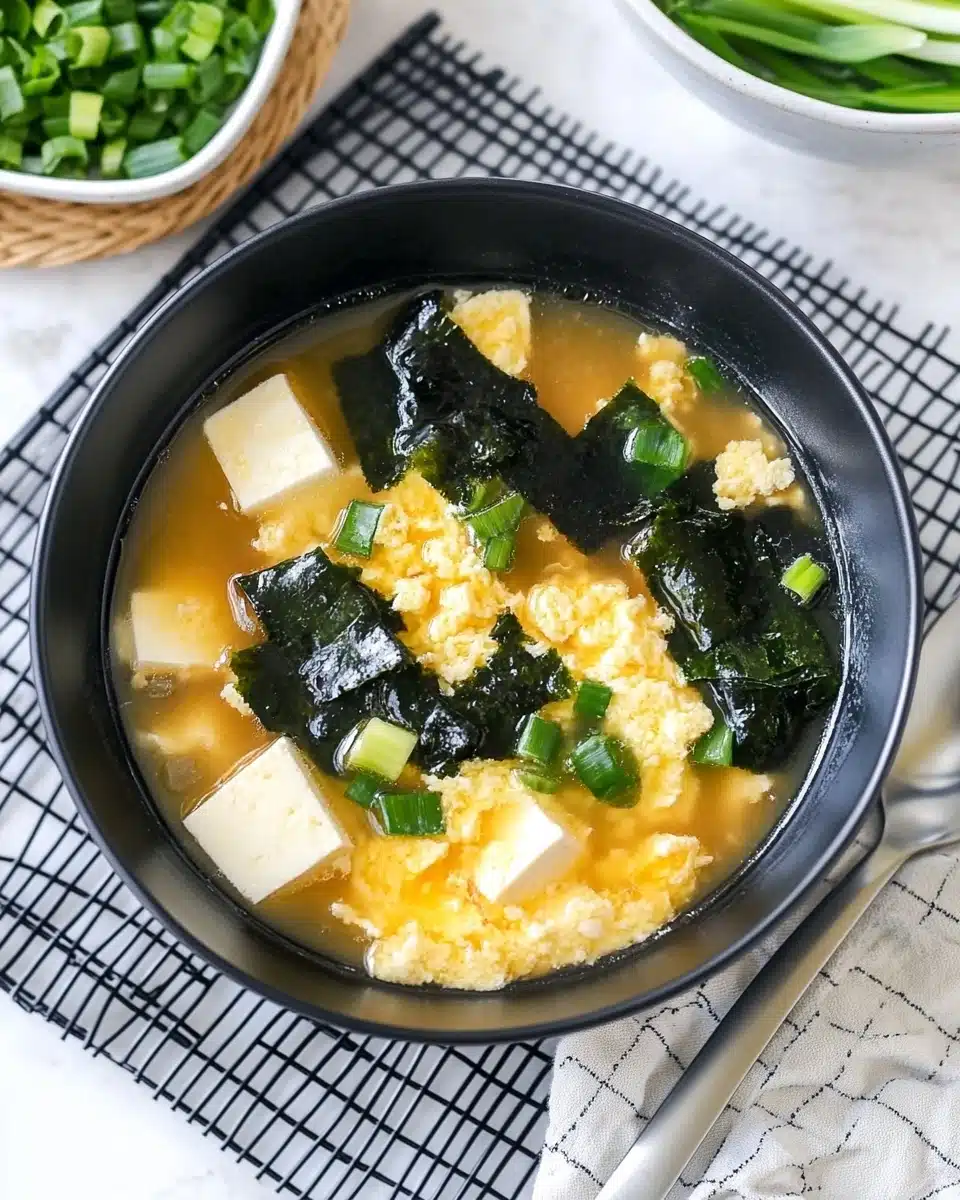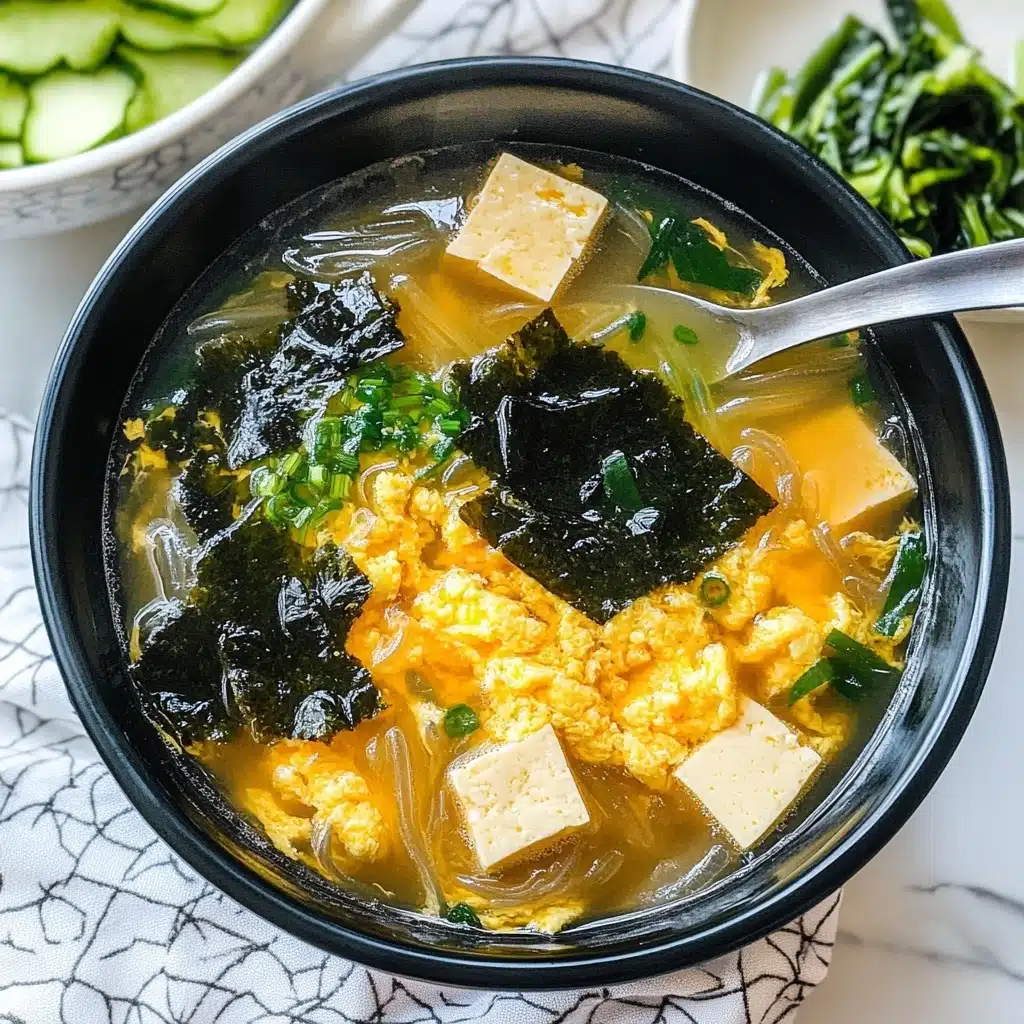If you’re an aficionado of light, slurpable soups with nourishing ingredients, Japanese Glass Noodle Soup is about to become your new favorite comfort food. This brothy, silky bowl offers an irresistible tangle of glass noodles, wispy ribbons of egg, tender tofu, earthy wakame, and springy scallions—all swimming in a savory, sesame-scented broth. It’s the kind of soup that’s deeply satisfying yet wonderfully easy; a gentle, restorative meal you’ll crave again and again.
Why You’ll Love This Recipe
- Truly Comforting: The luxurious broth and softly cooked eggs wrap you in warmth with every spoonful.
- Quick & Simple: From start to finish, Japanese Glass Noodle Soup can be on your table in just 15 minutes—no complicated steps required.
- Customizable Goodness: It’s delicious as written but effortlessly adapts to your dietary needs, from vegan and gluten-free to protein-packed with extra toppings.
- Complete Meal-in-a-Bowl: Glass noodles, protein, and veggies create a nourishing bowl that satisfies—no extra fuss needed.
Ingredients You’ll Need
This Japanese Glass Noodle Soup shines with a handful of wholesome, easy-to-find ingredients, each playing a starring role in the flavor, texture, and color of your bowl. Pay attention to the little details—even a humble pinch of white pepper brings surprising depth!
- Large Eggs: Whisked and drizzled in, they create beautiful silky ribbons for richness and a cloud-like texture.
- Green Onions/Scallions: The white parts impart a mellow, aromatic base, while the bright green tops add pop and freshness at the end.
- Medium-Firm Tofu: These hearty cubes soak up broth and provide gentle plant-based protein, balancing the soup.
- Dried Wakame Seaweed: Adds a delicate briny, ocean-kissed note and a welcome contrasting texture.
- Toasted Sesame Oil: Just a drizzle infuses the broth with nutty, toasty aroma that’s unmistakably Japanese.
- Chicken Stock/Broth: The savory backbone of the soup. Use a flavorful but not too-salty brand, or swap for veggie stock if you’d like.
- Water: Lightens the broth, helping the flavors mingle while letting the noodles and seaweed shine.
- Soy Sauce: Lends inky color and the signature umami that ties every ingredient together. Use gluten-free, if needed.
- Kosher Salt: For seasoning and punch—taste as you go, since different broths vary in saltiness.
- White Pepper Powder: A classic Japanese touch for subtle heat and complexity.
- Dried Glass/Cellophane Noodles (Harusame): Soft, slippery noodles that soak up the broth—a must for that signature “glass noodle soup” texture.
- Toasted White Sesame Seeds: Sprinkled at the end, these little gems add nuttiness and an appealing crunch.
Variations
The beauty of Japanese Glass Noodle Soup lies in its flexibility. Don’t hesitate to improvise—this soup welcomes your creativity, substituting with what’s in season or in your fridge, and easily morphs to suit any diet or craving!
- Vegan Version: Swap chicken broth for vegetable broth, and skip the eggs—a scoop of miso makes a gorgeous, creamy variation.
- Protein Boost: Add cooked shrimp, shredded chicken, or gently poached fish at the end for a heartier bowl.
- Sneak in Veggies: Toss in thinly sliced shiitake mushrooms, baby spinach, carrots, or snap peas for extra color and nutrition.
- Spicy Kick: A swirl of chili oil or sprinkling of shichimi togarashi gives your glass noodle soup a delightful warmth.
- Gluten-Free Option: Use tamari or certified gluten-free soy sauce and confirm your noodles are naturally GF for an allergen-friendly twist.
How to Make Japanese Glass Noodle Soup
Step 1: Prep All Your Toppings
Begin by beating the eggs in a spouted cup or bowl until smooth—it’s easier to drizzle them into the soup later. Slice the green onions, keeping the white and green parts separate for different stages of cooking, then cube your tofu. Quickly rehydrate the wakame by soaking it in water, then draining and squeezing gently. Assembling these toppings beforehand makes the rest of your soup assembly fast and stress-free!
Step 2: Build Flavor in the Pot
In a medium pot over medium heat, warm the toasted sesame oil until fragrant. Add the sliced white parts of the scallions and stir-fry for about 30 seconds—this little step unlocks their flavor and infuses the oil, forming a delicious base for your broth.
Step 3: Make the Broth
Pour in the chicken stock and water, then stir in the soy sauce, salt, and white pepper. Cover and bring everything to a boil. This step helps all the aromatics and seasoning meld into a cohesive, umami-rich broth that sets the tone for the entire Japanese Glass Noodle Soup experience.
Step 4: Add Tofu and Noodles
Once your broth is bubbling, carefully add the tofu cubes and dried glass noodles. Follow your package’s suggested cooking time for the noodles, giving them a good stir at the start so they don’t stick. You’ll start to see them go from opaque to clear—this is when their magical texture shines!
Step 5: Drizzle in the Eggs
When the noodles are just tender, reduce the heat to a gentle simmer. Very slowly, pour the beaten eggs into the center of the pot in a steady spiral while gently swirling with chopsticks, if desired. Let them set undisturbed for about 20–25 seconds. This trick ensures soft, beautiful egg ribbons instead of scrambled eggs—so pretty and so tasty!
Step 6: Finish and Serve
Add the rehydrated wakame, green parts of the scallions, and sprinkle with toasted sesame seeds. Remove the pot from the heat so nothing overcooks. Divide the glass noodles between bowls using tongs, then ladle the piping-hot soup over each serving. Japanese Glass Noodle Soup is ready to serve—dig in while it’s wonderfully warm!
Pro Tips for Making Japanese Glass Noodle Soup
- Egg Ribbon Magic: Pour the beaten egg in a slow, steady stream while the soup gently simmers—don’t stir—so you get delicate, picture-perfect egg ribbons.
- Noodle Texture Matters: Glass noodles can go from delightfully slippery to mushy in seconds, so keep a close eye and taste early for that perfect ‘al dente’ bite.
- Wakame Revamp: Squeeze the rehydrated wakame well before adding—excess water can dilute your broth and throw off the balance of the soup.
- Customize On the Fly: Adjust salt, soy, or spice right before serving, since brands and palates vary—Japanese Glass Noodle Soup should taste light yet satisfyingly savory.
How to Serve Japanese Glass Noodle Soup

Garnishes
A generous sprinkle of toasted sesame seeds, a scatter of fresh green scallion tops, or a few extra strands of wakame make each bowl irresistibly pretty and layered in flavor. If you love a touch of brightness, a swirl of chili oil or a squeeze of fresh lime adds a little sparkle on top of your Japanese Glass Noodle Soup.
Side Dishes
For a truly complete meal, serve your Japanese Glass Noodle Soup with crispy gyoza, a refreshing cucumber sunomono salad, or simple steamed edamame. If you’re feeling extra cozy, try adding on a side of pickled vegetables or a few pieces of tempura to contrast the soup’s delicate textures.
Creative Ways to Present
Let each guest build their bowl! Arrange bowls of extra toppings—sliced veggies, chili threads, nori strips, or soft-cooked eggs—on the table for personalized flair. Serve the Japanese Glass Noodle Soup in clear bowls so the layers of shimmering noodles, tofu, and egg are on full display. For a playful dinner party, offer miniature soup bowls as an appetizer course.
Make Ahead and Storage
Storing Leftovers
Leftover Japanese Glass Noodle Soup keeps well in an airtight container in the fridge for up to 3 days. The noodles might absorb a bit of broth as they rest, but the flavors deepen, making each reheat extra cozy and savory!
Freezing
If you’d like to freeze extra soup, portion it out without the noodles (cooked noodles can become too soft after thawing). Freeze the broth, tofu, and veggies in airtight containers, then add freshly cooked glass noodles when you’re ready to reheat and serve.
Reheating
To reheat, gently warm the soup over low to medium heat on the stove, adding a splash of water or broth if needed to loosen. Avoid boiling; just heat until steamy, and enjoy your Japanese Glass Noodle Soup just like new!
FAQs
-
What are glass noodles made from, and are they gluten-free?
Glass noodles, also called harusame or cellophane noodles, are typically made from mung bean starch or potato starch, giving them their signature translucent appearance after cooking. They are naturally gluten-free, but always check packaging for cross-contamination if you have a serious gluten allergy.
-
Can I add meat or seafood to Japanese Glass Noodle Soup?
Absolutely! This soup loves additions. Gently poached shrimp, shredded rotisserie chicken, or thinly sliced beef (like in sukiyaki) all work beautifully. For best results, add meat toward the end so it stays tender and juicy.
-
Is there a vegetarian version of this soup?
Yes! Swap chicken broth for a flavorful vegetable broth, and skip the eggs if you desire a fully vegan soup. Toss in extra tofu or mushrooms for hearty, plant-based texture.
-
How do I keep the egg from turning into scrambled bits?
For elegant, feathery egg ribbons, pour the beaten egg in a slow swirl around the simmering (not boiling) soup and resist the urge to stir immediately. Letting the egg settle for 20–25 seconds before gently moving it ensures picture-perfect results every time.
Final Thoughts
If you’re craving something restorative, comforting, and customizable, Japanese Glass Noodle Soup is your invitation to ladle up a steaming bowl of joy—right in your own kitchen. Make it once and I promise, it’ll find a permanent place in your kitchen rotation. I can’t wait for you to try it!
Print
Japanese Glass Noodle Soup Recipe
- Prep Time: 15 minutes
- Total Time: 15 minutes
- Yield: 4 servings
- Category: Stovetop
- Method: Stovetop
- Cuisine: Japanese
- Diet: Vegetarian
Description
This Japanese Glass Noodle Soup is a comforting and nutritious dish featuring a flavorful broth, tender tofu, delicate glass noodles, and a beautiful egg ribbon. It’s a satisfying meal that warms you from the inside out.
Ingredients
Eggs:
- 2 large eggs (50 g each w/o shell)
Green Onions/Scallions:
- 2 green onions/scallions
Tofu:
- 3.5 oz medium-firm tofu (momen dofu) (1/4 block)
Dried Wakame Seaweed:
- 2 Tbsp dried wakame seaweed
Toasted Sesame Oil:
- 2 tsp toasted sesame oil
Chicken Stock/Broth:
- 2 cups chicken stock/broth (use vegetable stock for vegan/vegetarian)
Water:
- 2 cups water
Soy Sauce:
- 1 1/2 Tbsp soy sauce (use gluten-free soy sauce for GF)
Diamond Crystal Kosher Salt:
- 1 tsp Diamond Crystal kosher salt (adjust based on your chicken stock as some brands can be salty; add 1/2 tsp first, then add more after tasting)
White Pepper Powder:
- 1/4 tsp white pepper powder
Dried Glass/Cellophane Noodles:
- 1 oz dried glass/cellophane noodles (harusame)
Toasted White Sesame Seeds:
- 2 tsp toasted white sesame seeds
Instructions
- Gather all the ingredients.
- Cut the green onions.
- Prepare the tofu.
- Rehydrate the wakame seaweed.
- Preheat the pot and add sesame oil.
- Add stock and seasonings.
- Add tofu and noodles.
- Add beaten eggs.
- Finish the soup.
Beat 2 large eggs (50 g each w/o shell) in a measuring cup or in a bowl with a spout.
Cut the white part of 2 green onions/scallions into thin round pieces. Then, thinly slice the green part diagonally. Set them aside separately.
Cut 3.5 oz medium-firm tofu (momen dofu) into ½-inch (1.3 cm) cubes.
Add 2 Tbsp dried wakame seaweed to a small bowl of water and rehydrate for 5 minutes. Then, drain and squeeze the water out. Set aside.
Preheat a medium pot over medium heat. When hot, add 2 tsp toasted sesame oil and the white part of the green onions. Stir-fry for 30 seconds.
Add 2 cups chicken stock/broth, 2 cups water, 1½ Tbsp soy sauce, 1 tsp Diamond Crystal kosher salt, and ¼ tsp white pepper powder. Mix well and bring to a boil.
Add tofu and 1 oz dried glass/cellophane noodles. Cook noodles per package instructions.
Slowly pour beaten eggs into the soup in a circular motion. Let them sit for 20–25 seconds until fluffy.
Add wakame seaweed, green onions, and sesame seeds. Remove from heat. Serve over noodles.
Nutrition
- Serving Size: 1 serving
- Calories: 216 kcal
- Sugar: 2g
- Sodium: 1210mg
- Fat: 12g
- Saturated Fat: 2g
- Unsaturated Fat: 8g
- Trans Fat: 0g
- Carbohydrates: 15g
- Fiber: 2g
- Protein: 15g
- Cholesterol: 186mg









